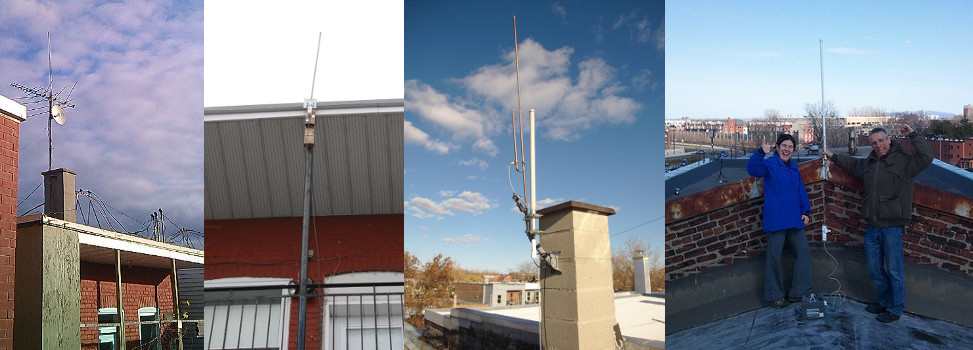Install planning
Before you go up on the roof with the hardware:
- Get clearance from the building owner to inspect the roof.
- Take pictures of the installation location.
- Figure one or two ways to run the network cable from the antenna to a power outlet.
- Get clearance from the owner to do the actual install.
- Buy the antenna and router.
- Flash the router with the firmware and test that you have access to it by wifi and wire.
- Get the hardware to mount the antenna.
- Find someone with installation experience to help you.
- Schedule installation when you have sun or light for 3 hours.
Voici une liste de suggestions de points à vérifier avant d'installer une antenne:
Installation sur un toit
- Combien d'étages a l'édifice?
- Photos du toit comme tel, et du panorama (ex: ?deuxpi, lacou)
- Est-ce qu'on peut installer sur le toit?
- Y a-t-il des ancres sur le toit que l'on pourrait re-utiliser? Ex: un vieux récepteur Express Vu, un mât d'antenne télévision, etc.
- Est-ce que l'on peut poser une nouvelle ancre? (sur la cheminée, sur le bord du toit, ..)
- Est-ce que le propriétaire du bâtiment est d'accord avec l'installation? Si oui, à quel endroit?
- Y a-t-il moyen de passer un câble ethernet pour alimenter l'antenne? Généralement cela implique de passer un câble ethernet à travers un cadre de fenêtre ou de porte. Souvent on peut enlever un vieux câble vidéotron, par exemple. Sinon percer un nouveau trou n'est pas compliqué.
Installation dans une fenêtre
- À quel étage?
- Y a-t-il une ligne de vue à partir de la fenêtre? Sinon, y a-t-il des voisins intéressés à poser une antenne sur leur toit?
Exemples: ?amman (soucoupe) /?bgm-latakia (bullet omni, par dessus l'antenne TV), tarator, ?boulette, grace.
Liens externes
Hardware required
To install an antenna on your roof, you will need at least the following hardware:
- mast & anchor: something to raise the antenna from the roof, if only a little - see antennes for details
- anchor holdings:
- concrete anchor bolts, if you drill it into concrete
- tripod with sandbags
- regular RJ-45 patch cables - to connect to the router without having to crimp cables!
- exterior-grade shielded network cable, see cabling for details
- shielded RJ-45 connectors
- plastic cable holders to secure the cable
- hose clamps may be useful to tie antennas to masts
- sealing tape, to seal the antenna connection with the router (for Bullets) - or electric tape works as well
- duct tape, for extreme hacks
- tie-wraps, same
- if using a 15 db omni antenna, two spacers to prevent the router from touching the mast (see ?elecnix for specifics)
- water: it gets hot up there
- power strip & 50' extension cord, esp. if drills are not battery-powered!
And tools:
- screwdriver with various heads
- X-acto
- crimping tool (and know how to use it, especially with shielded cables
- cable tester (e.g. Amazon or Home Depot)
- pliers with a cutting edge
- locking pliers (AKA "vise grip")
- drill and drill bits, hammer drill if you drill through concrete
- long drill bit (and drill) if you drill through wall or window frame (at least 30cm)
- laptop that you know for sure can talk to the mesh, with a working battery
Not absolutely necessary, but can be really useful:
- VHF radios to talk between the roof and ground, or between relays
- long measuring tape or spool to determine cable length
